The Oxford Dictionary defines biodiversity as “the variety of life in…a particular habitat or ecosystem.”
The variety of life…where do you go to experience natural diversity?
State forests and state parks are an obvious answer. You also might have a local park or favorite hiking trail that you enjoy visiting.
One place that might not immediately come to mind is your own yard.
If you’re like most Americans, you mow your lawn regularly to have a place for gathering with friends and space for your family to play. Lawns, while integral to our lives, largely lack in biodiversity.
Lawn is ‘Robin’ You of Better Birdwatching
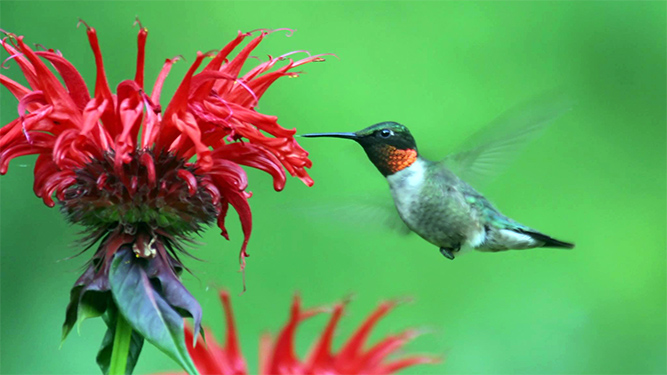
The classic backyard robin -- we watch them outside our windows as they bounce over the grass and swiftly yank worms out of the ground.
What other feathered friends visit our yards? Maybe a chickadee flits onto a feeder to grab a seed.
Mourning doves coo from a powerline, and if you’re lucky, you’ll catch a glimpse of a vibrant red cardinal perched in a bush.
It’s a familiar cast of avian characters that we’re affectionate for, but they’re quickly disappearing.
Research from Cornell Laboratory of Ornithology is sounding the alarm -- North American birds have experienced an overall 29 percent decline in abundance between 1970 and 2018.
That’s nearly three billion birds gone. And it’s not just specialist species, which require specific habitats or food sources, that are trending downward.
Common birds, like red-winged blackbirds and dark-eyed juncos, have declined by 92 million and 168 million, respectively, during the same time.
While a variety of factors are impacting bird populations, such as window impacts and predation by outdoor cats, loss of habitat is a top cause.
It’s not just birds feeling the impact. Insect and amphibian populations are also declining globally.

Increasing urbanization, intensive agriculture, and non-native landscaping are all greatly reducing habitat variety that would otherwise support greater bird and pollinator abundance.
Expectations of lawns are increasingly characterized by a desire for less -- fewer weeds, fewer insects, and fewer brown patches.
With more lawn that has less, there’s less biodiversity to support birds and other native wildlife.
Wildlife has three basic survival needs: food, water, and shelter. Expanses of pure, short-turf grasses can hardly fulfill these needs.
Without flowers, there’s no nectar for a butterfly to drink. Without native plants, there’s no food for hungry caterpillars. Without hollow stems, native female bees don’t have anywhere to lay their eggs and reproduce.
There’s nowhere for critters to seek refuge from a sweltering summer sun or pelting of a rainstorm.
As a result, the abundant flat sea of green lawn around the human-built environment contributes to a noticeable absence of variety.
The cure for backyard minimalism and sameness? Backyard maximalism -- replacing lawn with a variety of native plants that in turn attract a variety of life.
Become a Backyard Maximalist
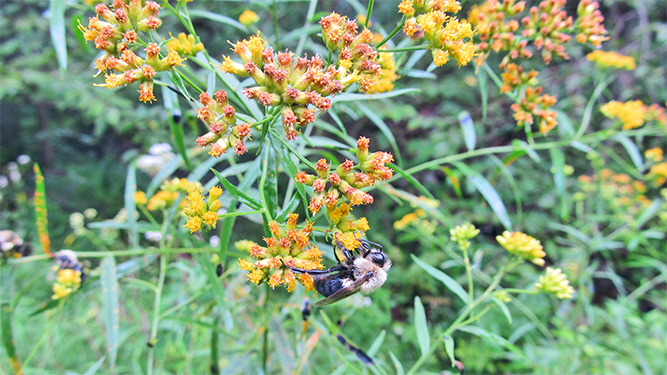
If you want more variety in life and want to see more wildlife streaming in and out of your yard, look no further than the native plant communities that wildlife depend on.
Plants form the basis of food webs. By capturing sunlight and turning it into energy, they are literal life providers.
Ensuring that native plants -- not the exotic ones that are typically found in home landscaping -- cover the landscape is key.
Native plants provide the right nutrients and physical structure that native pollinators, insects, birds, and other wildlife have adapted to and rely on to persist.
Native plants can support a greater diversity and abundance of insects, which means more food for birds.
Pennsylvania has approximately 2,100 plant species that call the Commonwealth home. Wherever you live, there are dozens of species that will thrive around your home with relative ease.
Go Against the (Green) Tide
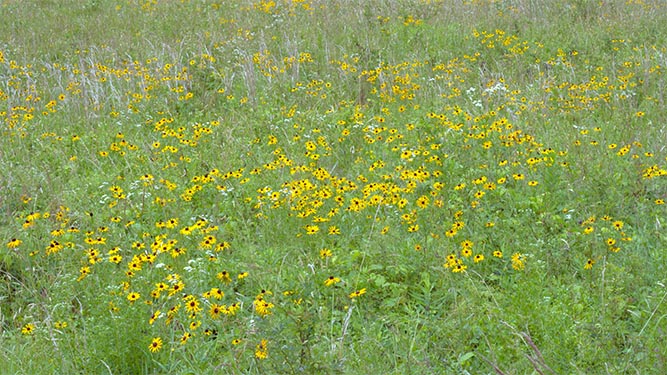
Invite native plants onto your property and you’ll be surprised by the life that they attract. Plant your gardens full of caterpillar food.
Every caterpillar will then become a butterfly or bird food. It’s a win-win either way!
There are many ways to introduce native plants into your yard:
Plant a Single Native Tree or Shrub
If you can only plant one tree, make it a white oak to support the highest diversity of pollinators.
According to research by Dr. Doug Tallamy, the stately white oak provides food for more than 500 different species of caterpillars. That’s a lot of bird food!
With a lifespan of several hundreds of years, a white oak you plant now can provide food and shelter for many generations.
But there are plenty of other woody plants to choose from. Plant spicebush to attract the spicebush swallowtail. For the luna moth, plant sweet gum.
Black cherries provide food for tiger swallowtails, red-spotted purples, and more than 400 other butterfly and moth species.
Expand and Diversify Your Garden Beds
Opt for natives when shopping at your local garden center this year. When planning your garden, be sure to plant more densely than you’re used to and consider expanding your beds.
As demand for native plants has grown, many garden stores now sell native species -- just ask their staff where you can find the natives.
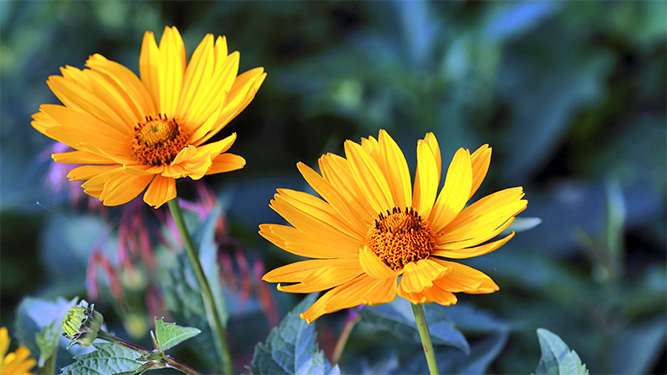
There are even plant nurseries that specialize in native plants. DCNR also has native garden templates to guide and inspire you. Common native wildflowers and grasses you can start with include:
- Wild bergamot (Monarda fistulosa)
- Oxeye sunflower (Heliopsis helianthoides)
- Hairy beardtongue (Penstemon hirsutus)
- Wild ginger (Asarum canadense)
- Little bluestem (Schizachyrium scoparium)
Convert Some of Your Lawn to Native Plants
Replacing your lawn with a variety of native trees, shrubs, wildflowers, and grasses is the ultimate way to maximize the biodiversity around your home.
Keep some lawn so you can continue to enjoy barbeques with friends or play fetch with your dog; but think about where you wouldn’t mind having a little less grass to mow -- edges, wet depressions, or along a waterway.
As you’re planning to reduce your lawn, follow these key principles:
- Don’t just “let it grow.” Don’t just let your existing landscape grow. You’ll need to remove the turf. Exotic lawn plants are the same at four inches and at 18 inches -- they are not caterpillar food. Tall grasses make it hard for native plants to establish; and inevitably, your neighbors, municipality, or homeowners’ association may deem your let-go lawn as abandoned.
- Pay attention to seed mixes to ensure you’re planting native perennial plants. The wildflower seed mixes you find at big box stores are commonly non-native, annual plants that don’t support native insects and don’t live on. There are many native seed suppliers that can help ensure you get the right plants for your property.
- Use “cues to care” to convey intention of your planting. “Cues to care” are design principles that native plant landscapers use when converting a lawn. Plant small plants in the front and taller plants in the back to lead the eye in a pleasing way. Incorporate mowed edges along paths to create a little separation between your planting and passers-by.
Get Ready to Unlock Biodiversity!
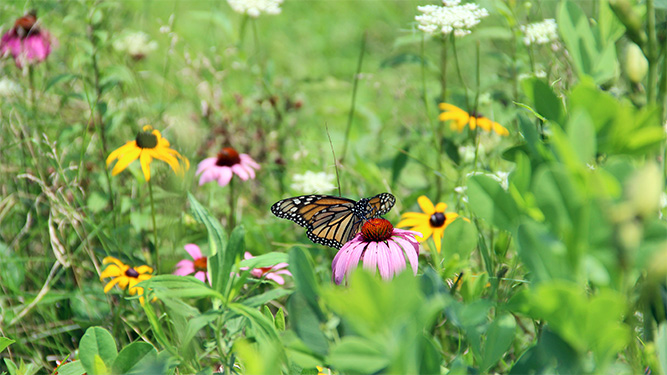
Nature yearns for more in the barrenness of the human-built landscaped environment. Native plants are the key to unlocking biodiversity.
Aside from creating habitat and providing food for birds, pollinators, and other wildlife, native plants also enrich our lives. Their dynamic textures, colors, and growing habits provide year-round interest and variety.
You don’t need to own vast acres of pristine habitat to benefit birds, pollinators, and wildlife. Biodiversity will be restored with the small efforts of many -- efforts that can start in your own backyard.
If you’re ready to convert some of your lawn to woods or meadow, visit the DCNR website to learn more about how you can make it happen.